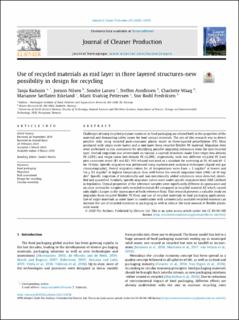| dc.contributor.author | Radusin, Tanja | |
| dc.contributor.author | Nilsen, Jorunn | |
| dc.contributor.author | Larsen, Sondre | |
| dc.contributor.author | Annfinsen, Steffen | |
| dc.contributor.author | Waag, Charlotte | |
| dc.contributor.author | Eikeland, Marianne Sørflaten | |
| dc.contributor.author | Pettersen, Marit Kvalvåg | |
| dc.contributor.author | Fredriksen, Siw Bodil | |
| dc.date.accessioned | 2020-03-26T07:06:22Z | |
| dc.date.available | 2020-03-26T07:06:22Z | |
| dc.date.created | 2020-03-25T15:02:36Z | |
| dc.date.issued | 2020 | |
| dc.identifier.issn | 0959-6526 | |
| dc.identifier.uri | https://hdl.handle.net/11250/2648710 | |
| dc.description.abstract | Challenges of using recycled polymer materials in food packaging are related both to the properties of the material and demanding safety issues for food contact materials. The aim of this research was to detect possible risks using recycled post-consumer plastic waste in three-layered polyethylene (PE) films produced with virgin outer layers and a mid-layer from recycled flexible PE material. Migration tests were performed as risk assessment for identifying possible migrating substances from the mid-recycled layer. Overall migration was determined on various 3-layered structures made from virgin low-density PE (LDPE) and virgin linear low-density PE (LLDPE), respectively, with two different recycled PE from post-consumer waste (R1 and R2). 95% ethanol was used as a simulant for screening at 20, 40 and 60 C for 10 days. Specific migration was performed using sophisticated analytical techniques (liquid and gas chromatography). Overall migration values for all temperatures were from < 2 mg/dm2 at lowest and 5.6 ± 0.1 mg/dm2 at highest temperature, thus well below the overall migration limit (OML) of 10 mg/dm2. Specific migration of intentionally and non-intentionally added substances were detected, identified and quantified. Similarly, specific migration values were under specific migration limit (SML) defined in legislation. Optical properties of the reference samples were significantly different in appearance and on cross section for samples with recycled materials R1 compared to recycled material R2 which caused only slight changes in the appearance of both reference films. This research presents a valuable study on migration from recycled flexible PE films and use of recycled materials in food packaging pplications. Use of virgin materials as outer layer in combination with commercially available recycled material can increase the use of recycled materials in packaging as well as reduce the total amount of flexible plastic solid waste. | en_US |
| dc.language.iso | eng | en_US |
| dc.rights | Attribution-NonCommercial-NoDerivatives 4.0 Internasjonal | * |
| dc.rights.uri | http://creativecommons.org/licenses/by-nc-nd/4.0/deed.no | * |
| dc.title | Use of recycled materials as mid layer in three layered structures-new possibility in design for recycling | en_US |
| dc.type | Peer reviewed | en_US |
| dc.type | Journal article | en_US |
| dc.description.version | publishedVersion | en_US |
| dc.source.volume | 259 | en_US |
| dc.source.journal | Journal of Cleaner Production | en_US |
| dc.identifier.doi | 10.1016/j.jclepro.2020.120876 | |
| dc.identifier.cristin | 1803537 | |
| dc.relation.project | Nofima AS: 11970 | en_US |
| dc.relation.project | Norges forskningsråd: 267648 | en_US |
| cristin.ispublished | true | |
| cristin.fulltext | original | |
| cristin.qualitycode | 2 | |

